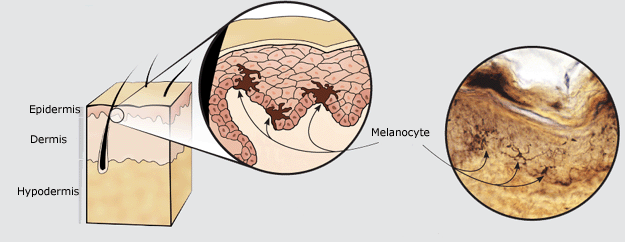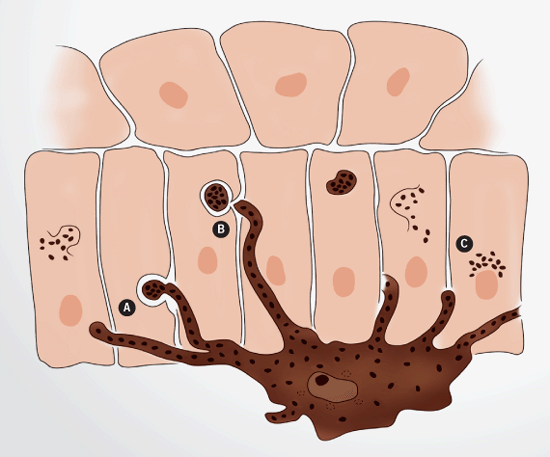Melanin
Umbrellas of Our Skin
The sun would kill every one of us if we had no protection. Sunscreen and parasols are not enough. Thankfully, God provided our skin with millions of miniature umbrellas, filled with melanin, to guard our bodies from the sun’s most deadly ultraviolet rays.
Umbrellas are not just for rain; they can also shade us from the sun. As Jonah sat sulking over God’s mercy toward Nineveh, God prepared a large plant—like a big umbrella—to shade him from the beating sun (Jonah 4:6). Just as our merciful God protected Jonah, He has provided our skin with millions of tiny umbrellas to protect us from the sun’s damaging rays.
Dangerous Ultraviolet Rays
In addition to visible light, the sun produces invisible light called ultraviolet (UV), which has a greater effect on our skin. Depending on the amount of exposure, UV light can be either beneficial or damaging. With moderate exposure, UV promotes the production of vitamin D in our skin, an essential for building strong bones and teeth. In larger doses, however (and especially at a certain wavelength), UV light can damage our skin, producing burns, premature skin aging, wrinkling, mutations, and skin cancer.
Melanin to the Rescue
Like all good sunshades, the umbrellas in our skin are darkly colored. The dark pigment in our skin, called melanin, is typically black or brown. This protein is produced by special cells, called melanocytes, which are located in the lowest level of our epidermis (the surface layer of our skin, Figure 1).

MANUFACTURING MELANIN (Figure 1): Melanin is the pigment primarily responsible for our skin color. Melanin is produced in special cells, called melanocytes, located in the lower layer of our epidermis (the surface layer of our skin).
Melanocytes themselves are not the umbrellas of our skin. They merely produce the melanin for our skin, in the form of tiny granules called melanosomes.
Our skin contains millions of tiny umbrellas containing melanin. These “umbrellas of the skin” protect us from burns, skin aging, wrinkling, mutations, and skin cancer.
Then they transfer the granules to certain epidermal cells in the lowest layer of our epidermis, where they block the damaging UV that penetrates our skin. In other words, melanocytes are like pigment factories that ship pigments (melanosomes) to other cells where the pigment is needed.
The mechanism to transfer the granules is itself amazing. The melanocyte is a highly branched cell with long, slender projections, or processes (Figure 2). The melanocyte makes the melanosomes which then move out to the tips of the cell processes. The epidermal cells then “bite off” the tips of these processes, bringing the granules inside their cell.
Once inside, the melanosomes are moved and arranged to form a dark “cap” over the epidermal cell’s nucleus. This pigmented cap serves as a tiny umbrella for the nucleus, specifically blocking the most damaging wavelength of the UV light (Figure 2).

DISTRIBUTING MELANIN (Figure 2): Once
melanin is manufactured, it is packaged into tiny granules, called melanosomes,
ready for shipment to nearby cells in the epidermis (epidermal cells). The
granules first are shipped to tips of long, slender projections, which branch
out from the melanocyte like tentacles on an octopus (A).
The epidermal cells then “bite off” the tips of these projections (B). Once
inside the epidermal cells, the precious melanosomes are moved and arranged
into dark “caps,” or umbrellas, over the cell’s nucleus (C). These caps protect
the nuclei from harmful ultraviolet light, especially when the cells divide.
UV radiation is most damaging when the epidermal cells are dividing to produce new cells. At this critical time, UV can damage the DNA (genetic information) in the nucleus, resulting in mutations and skin cancer.
The only cells that face this danger are the stem cells, the only cells in the epidermis capable of dividing. These cells reside in the deepest layer of the epidermis. And amazingly, only these vulnerable stem cells get the precious melanosomes.
There Are No “White” People
Human skin is normally never truly white, though some people have less melanin in their skin than others. Surprisingly, all humans, regardless of the shade (“color”) of their skin, have approximately the same number of melanocytes per square inch of skin.
Even albinos have melanocytes, but they produce colorless, rather than pigmented, melanosomes. The granules are colorless because the enzyme necessary for producing melanin is either missing or defective.
Interestingly, these colorless melanosomes are still taken into the epidermal stem cells, where they form an umbrella just as in normal skin. The result, however, is something like a clear plastic umbrella—not very good for warding off the sun.
Some people have darker skin than others, not because they have more melanocytes but because they retain a greater amount of melanin after the cells are no longer able to divide. People with lighter shades of skin break down most of their melanosomes.
While DNA is less vulnerable to UV when the cells no longer divide, retaining more pigment is still advantageous. People with darker skin are more resistant to sunburns and skin cancer. Yet people with very dark skin face another problem—they may not be able to produce enough vitamin D.
Like the miraculous plant that God provided to shade Jonah, each umbrella in our skin is a miracle for which we “have not labored, nor made it grow” (Jonah 4:10). We are no more deserving of this merciful, God-given shade than Jonah was.
Let us then give thanks for all the undeserved provisions that God has given us through Christ, who protects and sustains both our body and soul from all that might harm us. Truly, “He is not far from each one of us; for in Him we live and move and have our being” (Acts 17:27–28).
Answers Magazine
October – December 2010
Human life is sacred, from fertilization until the day we die. This issue focuses on a creation-based understanding of the sanctity of life and mankind’s violation of the Creator’s clear directives.
Browse IssueRecommended Resources

Answers in Genesis is an apologetics ministry, dedicated to helping Christians defend their faith and proclaim the good news of Jesus Christ.
- Customer Service 800.778.3390
- Available Monday–Friday | 9 AM–5 PM ET
- © 2025 Answers in Genesis






